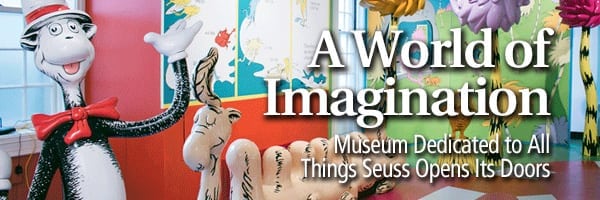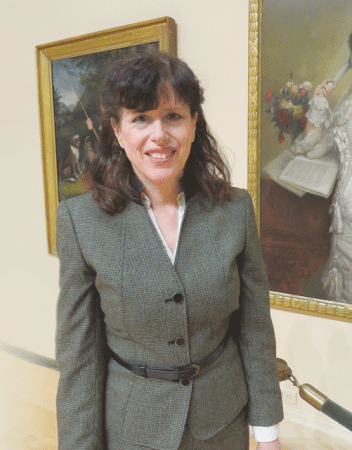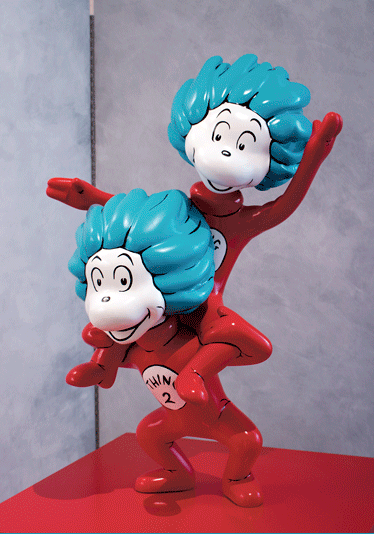
Museum Dedicated to All Things Seuss Opens Its Doors
A World of Imagination

By Kathleen Mellen
It’s called the Amazing World of Dr. Seuss, and that pretty much says it all. One of Springfield’s favorite sons, the good doctor actually created dozens of amazing worlds through his timeless books. The museum that opened on June 3 pays tribute to many of them, but also to the city that inspired Theodor Geisel to dream, create, and delight generations of children and adults.
There’s so much to tell, and so much to see,
Put your thinking cap on and let yourself be.
Amazed by the world of the good Dr. Seuss,
Keep your eyelids up, and your brainy cells loose.
From murals to statues to wordplay and more,
There are things to delight, and stories galore.
His table, his Emmys, and his bright pencils, too,
Are there to peruse in displays just for you.
It’s all on view now, in a museum, brand-new,
For kids of all ages, and, yes, parents, too.
It’s right here in Springfield, a real downtown treat,
And to think you can see it on old Edwards Street!
Eight years ago, the president of Springfield Museums, Kay Simpson, had the germ of an idea: Why not create a permanent, indoor display featuring the work of the wildly popular Dr. Seuss, author of 44 children’s books that have sold hundreds of millions of copies, and have been translated into more than 20 languages?
After all, the Museums already unveiled an outdoor exhibit in 2002, the Dr. Seuss National Memorial Sculpture Garden, to honor the Springfield native, whose real name was Theodor Seuss Geisel. The sculptures — created by Seuss’ stepdaughter, Lark Grey Dimond-Cates — proved to be so popular, Simpson said, that they helped put the Museums on the map; all of a sudden, there were cars in the parking lot from states across the U.S.
“That was really exciting,” she recalled. “It increased our visitation and changed the demographics. It made us a national attraction.”
As popular as the sculpture garden proved to be, however, 80% of the visitors surveyed indicated they’d like to see an indoor exhibit as well, Simpson said. And she agreed.

Kay Simpson says the Dr. Seuss sculpture garden raised the profile of the Springfield Museums nationally, and a full museum dedicated to all things Geisel was the next logical step.
“We began our thinking about creating a museum based on the response we got from the sculpture garden,” Simpson told BusinessWest just days before the June 3 opening of the Amazing World of Dr. Seuss, as workers put the finishing touches on the museum — painting walls, waxing floors, and mounting displays. “People loved the sculptures, but everyone wanted an indoor museum experience.”
So, after eight years of planning, refurbishing the former Connecticut Valley Historical Museum (its holdings were moved to the Lyman and Merrie Wood Museum of Springfield History, also part of the Springfield Museums), fund-raising to the tune of nearly $7 million, and collaborating with Dr. Seuss Enterprises, artists, educators, and members of the Seuss family, the Amazing World of Dr. Seuss opened this month as a three-story, permanent homage to one of Springfield’s icons.
The museum was funded through contributions from area investors, including MassMutual, the Community Foundation of Western Massachusetts, and the Irene E. and George A. Davis Foundation, as well as through a capital campaign. To date, the museum has raised $6.5 million of its $7 million goal. It was designed by artist John Simpson, Kay’s husband, who teaches art at the Commonwealth Honors College at UMass Amherst.
The first floor uses colorful, three-dimensional displays with interactive components to explore Geisel’s childhood in Springfield, as well as the characters and stories that sprang from his imagination.

Museum planners envisioned an educational experience populated with Dr. Seuss’ most famous characters.
The second floor features the collections of Geisel’s stepdaughters, Leagrey Dimond and Lake Grey Dimond-Cates, and Ted Owens, Geisel’s grandnephew, and is curated by the family members under the guidance of Springfield Museums Vice President Heather Haskell, and curatorial staff.
On the lower level is “Cat’s Corner,” a Dr. Seuss-themed educational space for ongoing art and literacy activities, overseen by a full-time Seuss educator.
In short, the world’s only museum dedicated to the life and work of Dr. Seuss is packed with wonders to discover.
Oh, the places he’d go! At life he was winning.
His birthplace in Springfield was just the beginning.
There were points to be scored. There were games to be won.
And now he’s our fair city’s favorite son.
Theodor Seuss Geisel was born in 1904 on Howard Street in Springfield’s South End, the grandson of Theodor Geisel, a German immigrant who owned Springfield Brewing Co., and his wife, Christine, and George and Margaretha Seuss, also immigrants from Germany, who ran a bakery on Howard Street, where Ted’s mother, Henrietta, worked.
Ted’s father, Theodor Robert Geisel, was the superintendent of Forest Park, including the zoo, and when Ted was 2, the family moved to a three-story house at 74 Fairfield St. in the Forest Park neighborhood; he lived there until 1921, when he left to attend Dartmouth College.
The young Geisel visited the zoo often, sometimes bringing along a sketchbook in which to draw fantastical versions of the animals he saw there (his sister Marnie teased her brother because his animal drawings had “mismatched features and were curiously exaggerated,” according to the museum’s website), some of which might well have inspired the illustrations in his 1950 book If I Ran the Zoo.
“We were interested, from the beginning, in really telling the Springfield story,” Simpson said. “Ted Geisel grew up in this city, spent his boyhood here. That was something Springfield could be proud of.”
Indeed, many of the exhibits refer to what Simpson calls “the Springfield Cycle” — books that were inspired by the sights and sounds of the city. Geisel’s first children’s book, And to Think That I Saw It on Mulberry Street (1937), is based on a real street in Springfield: beer trucks used to barrel along it on their way to his grandfather’s brewery. The heavily traveled road was part of Ted’s stomping grounds, Simpson said, and might have inspired the young dreamer to imagine the likes of a “gold and blue chariot … rumbling like thunder down Mulberry Street.”
Geisel was also inspired by some of the more dramatic buildings in Springfield, like the Howard Street Armory, which resembles a castle, and the Barney Mausoleum in Forest Park, replete with its sphinxes and winding staircases, both of which show up in fantastical form in books like The 500 Hats of Bartholomew Cubbins (1938).
“He said that growing up in Springfield had an imprint on him and his creative imagination,” Simpson said. “He drew his impressions from growing up in a city with a lot of industrial buildings, and Victorian and post-Victorian monuments.”
If the sun starts to shine, or rain’s on the way,
The brand-new museum’s a good place to play.
It’s great to be there. You will like it a lot,
If the outside is cold, or exceedingly hot.
With its vibrant primary colors and murals depicting scenes from And to Think That I Saw It on Mulberry Street and The Cat in the Hat, the entryway sets the stage for this museum about all things Seuss. There to greet visitors just inside the front door is a life-size policeman from Mulberry Street, uniformed in bright blue, sitting astride his motorcycle, perhaps modeled on Springfield’s own Indian brand. Emblazoned on his cap are the words “Police 304, Springfield, Massachusetts.”
Kids are invited to crawl aboard. In fact, every Seussian structure in the museum, like the seven-humped Wump of Gump from 1960’s One Fish, Two Fish, Red Fish, Blue Fish, for example, was fabricated by Symmetry International Inc. in Rhode Island, using a special foam that has been treated for strength and resilience, and is virtually indestructible. “Kids can touch them all,” said museum spokeswoman Karen Fisk. “We can just wash them at the end of the day.”
Other first-floor exhibits include Young Ted in Springfield, which features a replica of the author’s childhood home, where visitors can use a touchscreen to “draw” on the bedroom wall, as Ted famously did as a child. In the Seuss Bakery, tiny visitors can pretend to bake their own pies; at McElligot’s Pool, inspired by the 1947 book by that name, they can play a digital fishing game; and in the Moose Juice and Goose Juice Factory, with its whimsical piping and artisan glasswork, they’ll explore gears and gadgets. In a replica of the Forest Park Zoo, children are invited to construct their own fantastical creatures using Lego blocks, as Seuss’ characters from the fictional McGrew Zoo peek at them from the windows.

The sculptures inside the museum are crafted from a virtually indestructible foam substance, so kids can feel free to handle and climb on them.
Also on the first floor is Readingville, devoted to developing reading skills through rhyming, the alphabet, and story games.
“We really tie the museum to literacy,” Simpson said. “Readingville is an homage to all those books he wrote that were about getting kids excited to read. Starting with The Cat in the Hat, he’s using limited vocabulary, rhymes. He’s connecting letters and words with illustrations in a way that helps kids to understand the association between pictures and the words and letters. He’s making reading fun; that’s really what it’s all about.”
From the inception, Simpson said, the museum has worked closely on the content and design of the reading-related exhibits with the Davis Foundation, whose “Read! Reading Success by 4th Grade” initiative promotes literacy in schools in Hampden County, as well as with reading specialists from Springfield schools and experts from Square One, which provides early-childhood education and support services in Springfield and Holyoke.
“We feel that’s especially important for the city of Springfield, where children have a demonstrated challenge with reading,” she said. “We want to help kids overcome that struggle and to become proficient readers, because it’s so important for them in terms of their own achievement, and for the future of Springfield.”
Related exhibits include the museum’s ABC Wall, an interactive, larger-than-life version of Dr. Seuss’s ABC (1963); when children touch a letter, they will hear its phonetic sound, and related artwork from the book will appear on the wall. In Green Eggs and Ham WordPlay, children enter the railroad cave from Green Eggs and Ham (1960) to find word-game stations, based on the rhyming vocabulary of the story. (Think: “I do not like them in a house. I do not like them with a mouse. I do not like them here or there. I do not like them anywhere.”)
Treasures await on the second floor as well, where memorabilia, gifted to the museum by Geisel’s stepdaughters and grandnephew, are on display, including items that have never been displayed publicly, like the quirky, illustrated notes Geisel wrote to his stepdaughters, whom he nicknamed Snunny and La Groo.
Visitors can imagine the beloved author at work in his studio, recreated here with his drawing table and chair, and the red rotary telephone he used to talk daily to his publisher, Random House, in New York City.
“We even have colored pencils he actually used,” Simpson said. “When I walk in here, it sends a shiver down my spine.”
Next door, guests will see living-room furniture from Geisel’s home in La Jolla, California, where he lived for many years until his death in 1991. Displayed alongside a collection of his books and fanciful hats are his two Emmy Awards (for Halloween Is Grinch Night in 1978 and The Grinch Grinches the Cat in the Hat in 1982) — just a couple of the many honors bestowed upon him, including a Pulitzer Prize in 1984 for his lifetime contribution to children’s literature.
Don’t sit in the house and do nothing at all.
It’s open in winter, spring, summer, and fall.
So pack up the kids if it’s rainy or sunny.
To the museum you’ll go, for fun that is funny!
Springfield’s leaders welcomed the opening of the Amazing World of Dr. Seuss with much fanfare. On May 30, Mayor Domenic Sarno read a proclamation on the steps of City Hall, declaring it Dr. Seuss Week, and the museum’s opening was heralded with a parade, called Cavalcade of Conveyances, down Mulberry Street.
Now open to the public, the museum is part of the seven-acre Springfield Museums complex at 21 Edwards St. in Springfield, which also includes the George Walter Vincent Smith Art Museum, the Springfield Science Museum, the Michele and Donald D’Amour Museum of Fine Arts, the Lyman and Merrie Wood Museum of Springfield History, and the Dr. Seuss National Memorial Sculpture Garden. One admission offers visitors access to all the sites. The cost is $25 for adults, $16.50 for students and seniors, $13 for ages 3 to 17, and free for children under 3.
“As a museum, we want to celebrate the artistic and literary achievements of Theodor Geisel, but we really want people to come and have a great time,” Simpson said. “It’s a joy to share all of this with our visitors.”





